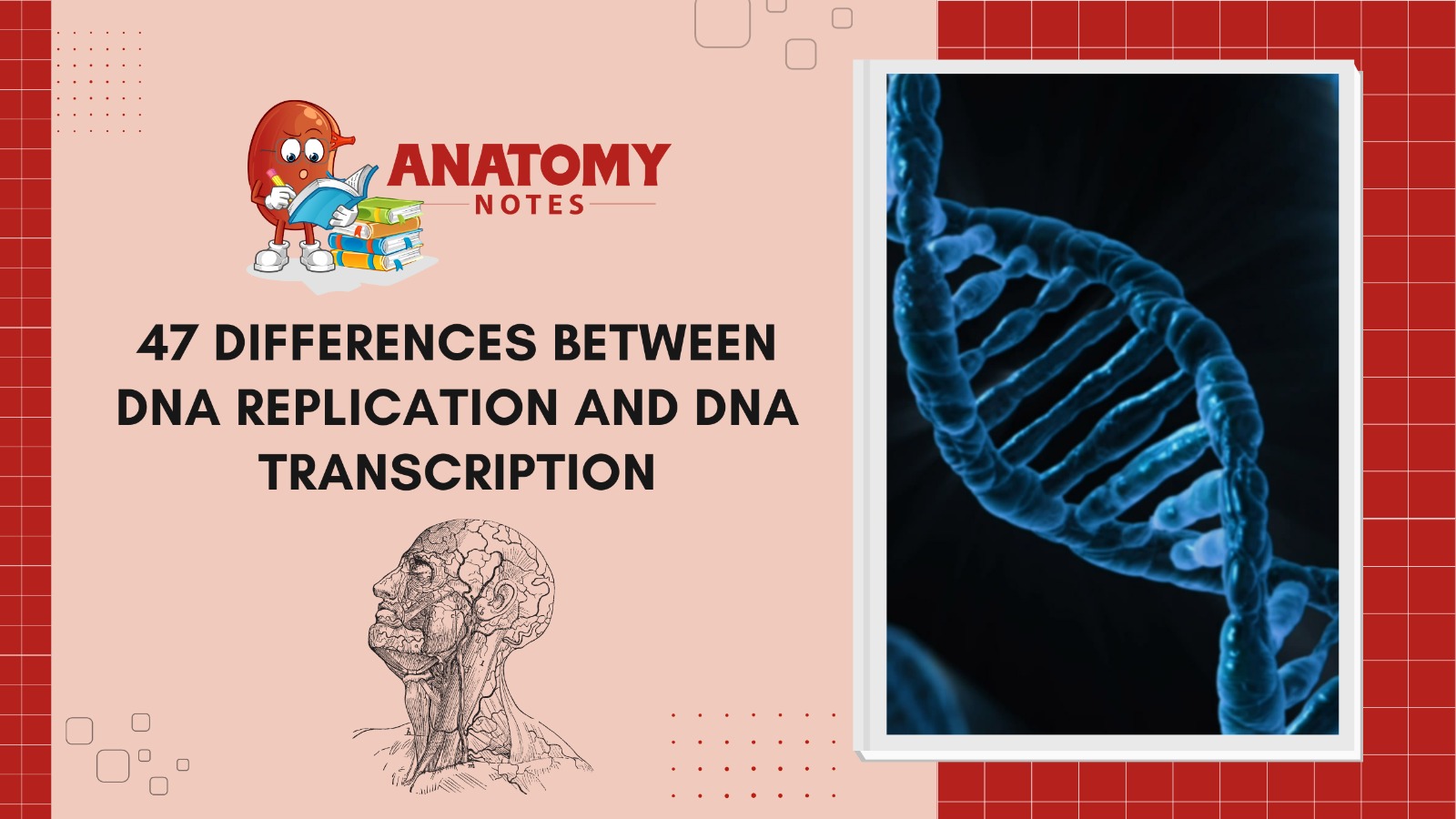DNA replication and transcription play diverse roles in cell function. Both change DNA, but they have different purposes and some major differences. To divide, cells duplicate their genomes during DNA replication. It ensures accurate genetic transmission. Replication begins at DNA helix origins. DNA helicase unwinds double-stranded DNA for replication forks. DNA polymerase then copies template strands. It’s 5′ to 3′. Semiconservative replication creates two DNA molecules containing one of the original strands and one produced from scratch.
Transcription creates RNA molecules from DNA templates. It is crucial to gene expression. This process produces mRNA, tRNA, and rRNA. Promoters are where RNA polymerase enzymes initiate transcription. RNA polymerase unwinds DNA and creates an RNA strand that matches the template DNA strand but has uracil (U) instead of thymine (T).
How DNA replication and transcription conclude is crucial. DNA replication creates two identical DNA molecules with one original and one freshly produced strand. RNA strands transport the genetic code from DNA to the ribosome, where proteins are produced.
Enzymes vary. DNA polymerase copies DNA. RNA polymerase synthesizes RNA during transcription. Both synthesis directions differ. DNA replication and synthesis begin in both directions. Transcription on a DNA template, however, is unidirectional. To preserve genetic material, DNA replication must be precise. Because the purpose of transcription is to generate functioning RNA molecules, it can tolerate certain errors.
In conclusion, DNA replication and transcription perform diverse functions in cells. DNA replication and transcription create RNA molecules for gene translation. Their outcomes, enzymes, synthesis direction, and error handling illustrate their diverse functions in cellular life.
Also Read: 18 Differences between acute and chronic pancreatitis
|
S.No. |
Aspect |
DNA Replication |
DNA Transcription |
|
1 |
Process Purpose |
Copying entire DNA molecule for cell division |
Synthesizing RNA from DNA for protein synthesis |
|
2 |
Enzyme Involved |
DNA polymerase |
RNA polymerase |
|
3 |
Template Strand |
Both strands act as templates |
One DNA strand acts as the template |
|
4 |
Resulting Product |
Two identical DNA molecules |
Single RNA molecule |
|
5 |
Complementary Base Pairing |
A-T, C-G |
A-U, C-G |
|
6 |
Location in Cell |
Nucleus |
Nucleus |
|
7 |
Occurrence |
S phase of cell cycle |
Throughout the cell cycle |
|
8 |
Nucleotides Used |
Ribonucleotides (NTPs) |
|
|
9 |
Primer Requirement |
Requires RNA primer |
No primer required |
|
10 |
Initiation Point |
Origin of replication |
Promoter region |
|
11 |
Direction |
Bidirectional |
Unidirectional, downstream |
|
12 |
Replication Forks |
Multiple forks |
Single transcription bubble |
|
13 |
Okazaki Fragments |
Formed on lagging strand |
Not applicable |
|
14 |
Proofreading Mechanism |
DNA polymerase’s 3′-5′ exonuclease activity |
RNA polymerase lacks proofreading |
|
15 |
Endonucleases |
Involved in excision repair |
Not directly involved |
|
16 |
Final Product Use |
DNA remains genetic material |
RNA used for protein synthesis |
|
17 |
Enzyme Rebinding |
Helicase, primase |
Not applicable |
|
18 |
Role of Ligase |
Sealing nicks in DNA backbone |
Not applicable |
|
19 |
Semiconservative Replication |
Yes |
Not applicable |
|
20 |
mRNA Molecules Produced |
None |
One mRNA per gene |
|
21 |
Catalyzing Reaction |
Phosphodiester bond formation |
Phosphodiester bond formation |
|
22 |
Resulting Molecules |
Two DNA molecules |
Single-stranded mRNA |
|
23 |
Protein Synthesis Connection |
Not directly involved |
Precedes translation |
|
24 |
Presence of Intron and Exon Sequences |
Not present |
Exons transcribed, introns removed |
|
25 |
Presence of Promoters and Enhancers |
Not applicable |
Important for initiation |
|
26 |
Ribonucleotide Incorporation |
No proofreading, lower fidelity |
Not as critical as in replication |
|
27 |
Sequence Start and End Signals |
Replication origin, termination sites |
Transcription start and stop signals |
|
28 |
Replication Licensing |
Involves licensing factors for origin firing |
Not applicable |
|
29 |
Role of Single-Stranded Binding Proteins |
Stabilizes single-stranded DNA regions |
Not applicable |
|
30 |
Antiparallel Nature |
Both strands are antiparallel |
Not applicable |
|
31 |
Process Complexity |
More complex due to fidelity preservation |
Comparatively simpler |
|
32 |
Role in Cellular Functioning |
Ensures accurate genetic transmission |
Transcribes genetic info for protein synthesis |
|
33 |
Association with Telomeres |
Can lead to telomere shortening |
No direct association |
|
34 |
Copying Errors |
Can lead to mutations |
Errors often less critical |
|
35 |
Replication of Specific Genes |
Replicates entire genome |
Transcribes specific genes |
|
36 |
Involved in Evolutionary Changes |
Can introduce genetic variation |
Primary source of genetic variation |
|
37 |
Strand Separation Mechanism |
Helicase unwinds strands |
RNA polymerase creates transcription bubble |
|
38 |
Replication Fidelity Mechanisms |
Proofreading, mismatch repair |
Errors less likely to affect cellular function |
|
39 |
RNA Processing |
Not involved in RNA processing |
Introns spliced, exons joined in mRNA processing |
|
40 |
RNA Stability |
Generally short-lived |
Varies based on RNA type |
|
41 |
Cellular Location of Process |
Nucleus |
|
|
42 |
End Product Modifications |
Methylation can be added post-replication |
Post-transcriptional modifications in mRNA |
|
43 |
Repair Mechanisms |
Proofreading, mismatch repair, nucleotide excision repair |
Errors often not repaired during transcription |
|
44 |
Enzyme Termination |
DNA polymerase completes replication |
RNA polymerase reaches termination sequence |
|
45 |
Strand Interaction |
Leading and lagging strands interact differently |
Template and non-template strands interact |
|
46 |
Product Modifications |
Methylation can be added post-replication |
Post-transcriptional modifications in mRNA |
|
47 |
Duplication vs. Transcription |
Produces a complete DNA copy |
Produces complementary RNA copy |
Also Read: Human Skin: Definition, Layers, Types, & Diseases
Frequently Asked Questions (FAQS)
Q1: What is the purpose of DNA replication and transcription?
DNA replication is essential for cell division because it duplicates the genome accurately. Transcription synthesizes RNA from DNA templates for protein synthesis and other cellular processes.
Q2: How do DNA replication and transcription differ in terms of enzymes involved?
DNA replication requires enzymes like helicase, polymerase, and ligase. DNA helicase unwinds double-stranded DNA, whereas DNA polymerase synthesizes new strands. DNA ligase bridges freshly synthesized DNA segments. RNA polymerase synthesizes DNA-complementary RNA strands during transcription.
Q3: What is the direction of synthesis in DNA replication and transcription?
Synthesis happens bi-directionally from the replication origin along the DNA strands. RNA synthesis usually proceeds unidirectionally along a DNA template, producing single-stranded RNA molecules.
Q4: How accurate are DNA replication and transcription processes?
DNA replication has a one-error-per-billion base pair rate. Genetic integrity requires this precision. Since the main purpose of transcription is to make functioning RNA molecules, it may tolerate certain mistakes.
Q5: What are the main products of DNA replication and transcription?
DNA replication produces two identical DNA molecules with one original and one freshly synthesized strand. Replicated DNA molecules divide cells and store genetic information. Transcription creates mRNA, tRNA, and rRNA. mRNA transfers the genetic code from DNA to ribosomes for protein synthesis, tRNA brings amino acids to the ribosome, and rRNA is a structural component.




